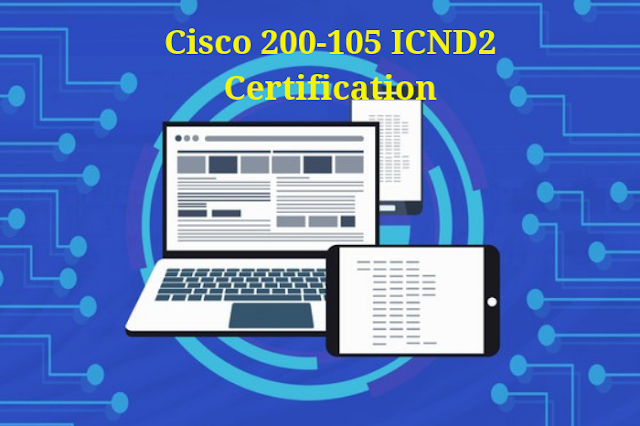o progress in any field, it is essential to be familiar with
the fundamentals of it. The CCNA Routing and Switching certification that you
achieve from passing the 200-105 exam is one of the most fundamental and
foundational certifications in the network technology. If you intend to make a
career as a network engineer, this certification is one you require to have
before you can move to a higher level certification.
The ICND2 certification is one that makes you familiar with
the fundamentals of networking, something that persists relevant even as
technologies develop and change over time. After all, any progress in these
technologies will rest on the fundamentals, so understanding the basics is
crucial for any right network specialist. This certification will teach you to
install, monitor, and troubleshoot network infrastructure products, something
that were and still are at the center of the Internet.
Obtaining your ICND2 certification means that you own the
basic knowledge to operate and oversee networks from all aspects, presenting
you as a qualified and desired professional in the field.
ICND2 exam topics emphasis on presenting the skills and
knowledge necessary to execute and support a small switched and routed network.
The 200-105 Interconnecting Cisco Networking Devices Part 2 (ICND2)
is the exam associated with the CCNA Routing and Switching certification. This
exam measures an applicant's knowledge and skills in LAN switching
technologies, WAN technologies, IPv4 and IPv6 routing technologies,
infrastructure services, and infrastructure maintenance.
Prerequisites
The recommended knowledge and skills that an applicant should
have to appear for ICND2 certification exam:
- Understand network fundamentals
- Implement local area networks
- Implement Internet connectivity
- Manage network device security
- Implement WAN connectivity
- Implement basic IPv6 connectivity
Theses exam topics outline for the content likely to be
covered on the Cisco Interconnecting Cisco Networking Devices Part 2 (ICND2)
exam.
ICND2 Exam Topics:
1. LAN Switching Technologies (26%)
1 Configure, verify, and troubleshoot VLANs (normal/extended
range) spanning multiple switches
- Access ports (data and voice)
- Default VLAN
2 Configure, verify, and troubleshoot interswitch
connectivity
- Add and remove VLANs on a trunk
- DTP and VTP (v1&v2)
3 Configure, verify, and troubleshoot STP protocols
- STP mode (PVST+ and RPVST+)
- STP root bridge selection
4 Configure, verify, and troubleshoot STP-related optional
features
- PortFast
- BPDU guard
5 Configure, verify, and troubleshoot (Layer 2/Layer 3)
EtherChannel
- Static
- PAGP
- LACP
6 Describe the benefits of switch stacking and chassis
aggregation
7 Describe common access layer threat mitigation techniques
- 802.1x
- DHCP snooping
- Nondefault native VLAN
2. Routing Technologies (29%)
1 Configure, verify, and troubleshoot Inter-VLAN routing
- Router on a stick
- SVI
2 Compare and contrast distance vector and link-state routing
protocols
3 Compare and contrast interior and exterior routing
protocols
4 Configure, verify, and troubleshoot single area and
multiarea OSPFv2 for IPv4 (excluding authentication, manual summarization,
filtering, redistribution, stub, virtual-link, and LSAs)
5 Configure, verify, and troubleshoot single area and
multiarea OSPFv3 for IPv6 (excluding authentication, filtering, manual
summarization, redistribution, stub, virtual-link, and LSAs)
6 Configure, verify, and troubleshoot EIGRP for IPv4
(excluding authentication, manual summarization, filtering, redistribution,
stub)
7 Configure, verify, and troubleshoot EIGRP for IPv6
(excluding authentication, manual summarization, filtering, redistribution,
stub)
3. WAN Technologies (16%)
1 Configure and verify PPP and MLPPP on WAN interfaces using
local authentication
2 Configure, verify, and troubleshoot PPPoE client-side
interfaces using local authentication
3 Configure, verify, and troubleshoot GRE tunnel connectivity
4 Describe WAN topology options
- Point-to-point
- Hub and spoke
- Full mesh
- Single vs. dual-homed
5 Describe WAN access connectivity options
- MPLS
- MetroEthernet
- Broadband PPPoE
- Internet VPN (DMVPN, site-to-site VPN, client VPN)
6 Configure and verify single-homed branch connectivity using
eBGP IPv4 (limited to peering and route advertisement using Network command
only)
4. Infrastructure Services (14%)
1 Configure, verify, and troubleshoot basic HSRP
- Priority
- Preemption
- Version
2 Describe the effects of cloud resources on enterprise
network architecture
- Traffic path to internal and external cloud services
- Virtual services
- Basic virtual network infrastructure
3) Describe basic QoS conceptsQoS concepts
- Marking
- Device trust
- Prioritization
- Congestion management
4 Configure, verify, and troubleshoot IPv4 and IPv6 access
list for traffic filtering
- Standard
- Extended
- Named
5 Verify ACLs using the APIC-EM Path Trace ACL analysis tool
5. Infrastructure Maintenance (15%)
1 Configure and verify device-monitoring protocols
- SNMPv2
- SNMPv3
2 Troubleshoot network connectivity issues using ICMP
echo-based IP SLA
3 Use local SPAN to troubleshoot and resolve problems
4 Describe device management using AAA with TACACS+ and
RADIUS
5 Describe network programmability in enterprise network
architecture
- The function of a controller
- Separation of control plane and data plane
- Northbound and southbound APIs
6 Troubleshoot basic Layer 3 end-to-end connectivity issues
Ever since the Cisco 200-105 ICND2 certification presented,
Cisco certifications have been desired by network engineers and organizations
all over the world. According to the latest study, Cisco skills are among the
most preferred skills in hiring requirements. They are incorporated more
frequently than 97 percent of all skills inquired. The requirement for an
intimate understanding of network infrastructure and protocols and how they
work together has always been important. Now, that need is raising. ICND2
certification qualifies you with the expertise and skills to succeed in
networking, even as technologies remain to evolve. The certification qualifies
you to how to install, monitor, and troubleshoot the network infrastructure
applications that are at the very heart of the Internet of Things.





0 comments:
Post a Comment